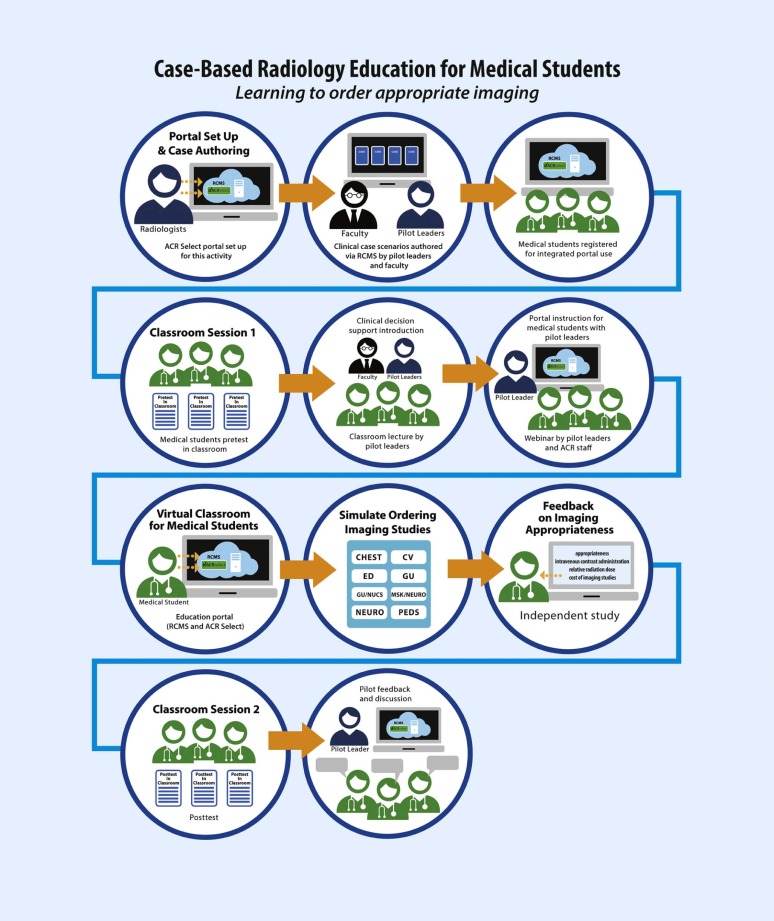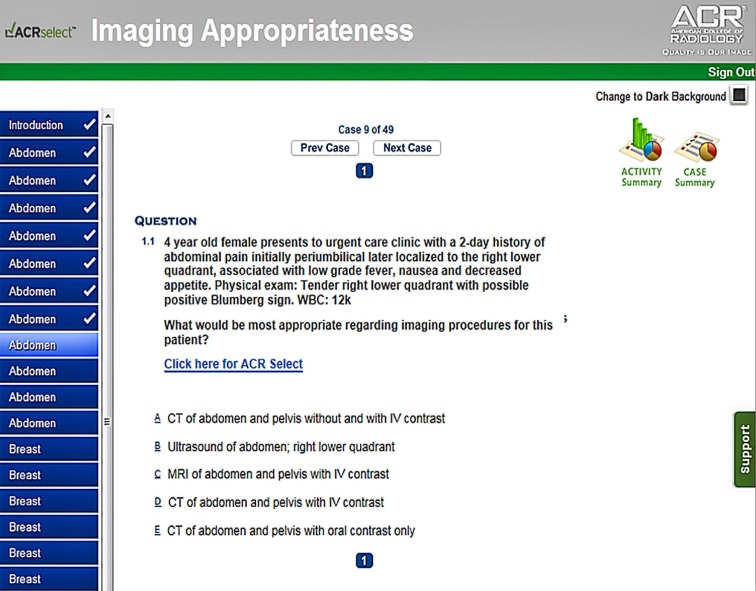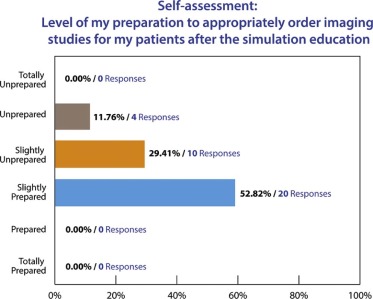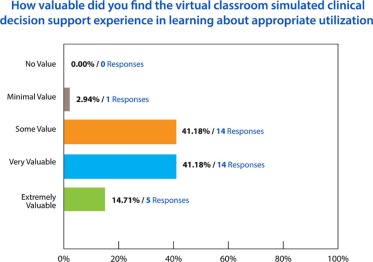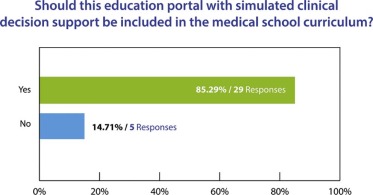Rationale and Objectives
We have been called to reform radiology undergraduate medical education (UME) curricula. Clinically available clinical decision support provides an opportunity to improve education regarding appropriate imaging utilization, patient safety, and cost-effective care.
Material and Methods
We created an education simulation portal utilizing integrated clinical decision support. The portal was then piloted with 34 volunteer medical students at our institution in a blended learning environment. A program assessment was performed utilizing the results from a qualitative survey, pre-test, and post-test.
Results
The large majority of medical students felt this supplemental education resource should be included in our UME curriculum (85.29%). All students perceived value in the education simulation portal. The students performed significantly better on the post-test in multiple categories (overall P <.0001), including Choosing Wisely topics ( P = .0207).
Conclusions
Based on our program assessment from this pilot program, we believe this innovative educational resource has significant potential to fill curricular gaps in radiology UME curricula. This platform is scalable and can be further customized to fill needs across the continuum of medical education.
Introduction
Medical imaging is an integral component of medicine, spanning the continuum of care. The invention of imaging modalities such as computed tomography, magnetic resonance imaging, and molecular imaging has significantly increased the reliance on medical imaging in clinical practice during recent decades . Contemporaneously, complimentary advances in information technology, informatics, and analytics are evolving at a staggering rate. These changes are superimposed upon a backdrop of healthcare reform. Undergraduate medical education (UME) curricula typically are not reflective of the omnipresence of imaging in the modern clinical practice; traditional curricula have not kept pace with these rapid advancements in technology and do not fulfill the evolving educational needs of medical students.
A call to reform radiology UME curricula has been made by medical school and radiology leadership. The large majority of medical students (95%) will pursue specialties other than radiology; therefore, evidence-based imaging utilization, cost-effective care, appropriate use of intravenous contrast, and judicious exposure of patients to medical radiation are essential elements to include in UME curricula . Although the American College of Radiology Appropriateness Criteria (ACR-AC) is a long-standing resource designed and available to facilitate appropriate imaging utilization, utilization has been low among medical students. The lack of an easy-to-use electronic format has been likely a barrier to medical student usage of the ACR-AC .
Get Radiology Tree app to read full this article<
Get Radiology Tree app to read full this article<
Get Radiology Tree app to read full this article<
Materials and Methods
Pilot Project
Get Radiology Tree app to read full this article<
Get Radiology Tree app to read full this article<
ACR Select
Get Radiology Tree app to read full this article<
Education Portal
Get Radiology Tree app to read full this article<
Get Radiology Tree app to read full this article<
Pre-Test
Get Radiology Tree app to read full this article<
Get Radiology Tree app to read full this article<
Introduction to the Pilot Project
Get Radiology Tree app to read full this article<
Simulation Education
Get Radiology Tree app to read full this article<
Post-Test
Get Radiology Tree app to read full this article<
Wrap-Up
Get Radiology Tree app to read full this article<
Program Evaluation
Get Radiology Tree app to read full this article<
Get Radiology Tree app to read full this article<
Results
Get Radiology Tree app to read full this article<
Get Radiology Tree app to read full this article<
Get Radiology Tree app to read full this article<
Get Radiology Tree app to read full this article<
TABLE 1
What Motivated You
Post-test Survey Question and Comments What motivated you to participate in this voluntary pilot project? Survey of the 38 learners completing the pilot Responses Learn more about ordering studies appropriately 11 Learn more about radiology 10 To have access to the clinical decision support tool (ACR Select) 6 To be helpful (medicine in general, my school) 4 Intrigued by the novel approach to learning 4 Become a better doctor 2Specific Comments “I really think there is an excess of ordering radiology tests in patients and I want to be a doctor who does what is needed and evidence proven, not someone who orders everything just to cover all the bases.” “I think that imaging is a huge part of the diagnostic process of medicine. There are so many different options that many clinicians and students do not fully understand so less appropriate tests of unnecessary tests are ordered that increase cost and increase discomfort and/or radiation exposure to the patient. This program could really help in preventing this and better guiding imaging decisions.” “I do not feel prepared to order correct imaging based on what I have learned in medical school so far. There is definitely a need for this in the curriculum.” “I felt highly unprepared when it comes to imaging modalities and ordering the appropriate tests, and felt overwhelmed by the radiology course in the pre-clinical curriculum. I thought this pilot program was a unique and interesting way to get more experience.” “Opportunity to participate with cutting edge clinical decision support software, which I feel is the future of medicine. I would also like to continue to use the program after the study.”
ACR, American College of Radiology.
TABLE 2
Education Portal
Post-test Survey Question and Comments How could the education portal be improved? Survey of the 38 learners completing the pilot Responses Recommended technical improvements:
13 More learning pearls provided with the answers 12 No recommendations and/or positive comment 7 Better matching of question stem with ACR Select information 3Specific comments “The cases were great overall. More explanation about the correct answer would be helpful in terms of learning. For instance, I’m still very confused about when to use contrast.” “I think that it has a lot of potential. Something that I would have found immensely useful would have been a short summary stating why the appropriate test was chosen (thought process, etc.).”
ACR, American College of Radiology.
TABLE 3
Support Tool
How could the clinical decision support tool (ACR Select) be improved? Survey of the 38 learners completing the pilot Responses Improved organization of the lists and columns within the interface 12 More information (“learning pearls”) in the decision support table 9 Improved function of the search tool 7 Less scrolling within the interface 6
ACR, American College of Radiology.
Get Radiology Tree app to read full this article<
Get Radiology Tree app to read full this article<
TABLE 4
Pre-test and Post-test
Results: Pre-test and Post-test Variable Pre-test Post-test_N_ Mean ± SD 15/50/85 Percentile_N_ Mean ± SD 15/50/85 Percentile_P_ -Value Introductory cases 38 3 ± 0.77 2/3/4 34 3.03 ± 0.63 2/3/4 .7501 Intermediate cases 38 1.74 ± 0.95 1/2/3 34 3 ± 0.85 2/3/4 <.0001 Advanced cases 38 1.66 ± 0.97 1/2/2.15 34 2.26 ± 0.86 1.25/2/3 .0013 Modality questions 38 1.95 ± 1.11 1/2/3 34 2.24 ± 1.05 1/2/3 .0731 Choose Wisely topics 38 1.5 ± 0.92 0.85/1/3 34 1.85 ± 0.74 1/2/3 .0207 Overall performance 38 8.82 ± 2.06 6/9/11 34 11.1 ± 1.9 9/11/13 <.0001
Get Radiology Tree app to read full this article<
Discussion
Get Radiology Tree app to read full this article<
Get Radiology Tree app to read full this article<
Get Radiology Tree app to read full this article<
Get Radiology Tree app to read full this article<
Conclusion
Get Radiology Tree app to read full this article<
Acknowledgments
Get Radiology Tree app to read full this article<
Get Radiology Tree app to read full this article<
Get Radiology Tree app to read full this article<
Get Radiology Tree app to read full this article<
Get Radiology Tree app to read full this article<
Get Radiology Tree app to read full this article<
References
1. Health Affairs Website : Physicians’ views of the relative importance of thirty medical innovations. Available at: http://content.healthaffairs.org/content/20/5/30/T3.expansion.html Accessed May 13, 2015
2. Straus C., Webb E., Kondo K., et. al.: Medical student radiology education: summary and recommendations from a national survey of medical school and radiology department leadership. J Am Coll Radiol 2014; 11: pp. 606-610.
3. National Resident Matching Program : Results and data: 2015 main residency match. Available at: http://www.nrmp.org/wp-content/uploads/2015/05/Main-Match-Results-and-Data-2015_final.pdf Accessed June 6, 2015
4. Kozak B., Webb E.M., Khan B.K., et. al.: Medical student usage of the American College of Radiology Appropriateness Criteria. Acad Radiol 2015; 22: pp. 1606-1611.
5. Wong B., Etchells E., Kuper A., et. al.: Teaching quality improvement and patient safety to trainees: a systematic review. Acad Med 2010; 85: pp. 1425-1439.
6. Cook D., Erwin P., Triola M.: Computerized virtual patients in health professions education: a systematic review and meta-analysis. Acad Med 2010; 85: pp. 1589-1602.
7. Ziv A., Wolpe P., Small S., et. al.: Simulation-based medical education: an ethical imperative. Acad Med 2003; 78: pp. 783-788.
8. Ruiz J., Mintzer M., Leipzig R.: The impact of e-learning in medical education. Acad Med 2006; 81: pp. 207-212.
9. Gaglani S., Topol E.: iMedEd: the role of mobile health technologies in medical education. Acad Med 2014; 89: pp. 1207-1209.
10. ACR Select : National Decision Support Company Website. Available at: http://www.acrselect.org/index.html Accessed May 14, 2015
11. ACR Website : The Choosing Wisely Imaging Exam Topics. http://www.acr.org/Advocacy/Economics-Health-Policy/Imaging-3/PQI-Initiative/Choosing-Wisely-Topics Accessed November 17, 2015
12. Choosing Wisely Website : Five things physicians and patients should question. http://www.choosingwisely.org/wp_content/uploads/2013/01/5things_12_factsheet_Amer_Coll_Radiology.pdf Accessed May 14, 2015
13. Institute of Medicine : Improving diagnosis in health care. http://iom.nationalacademies.org/Reports/2015/Improving-Diagnosis-in-Healthcare.aspx Accessed October 23, 2015
14. ACR Website : Radiologists and clinical decision support. http://www.acr.org/Advocacy/Economics-Health-Policy/Imaging-3/Presentations/Radiologists-and-Clinical-Decision-Support Accessed May 14, 2015
15. ACR Website : Landmark medical imaging provisions in SGR “patch” to help usher in new era of evidence-based medicine. http://www.acr.org/About-Us/Media-Center/Press-Releases/2014-Press-Releases/20140331Landmark-Medical-Imaging-Provisions-in-SGR-Patch Accessed May 14, 2015
16. Congress Website : H/R/4302-Protecting access to Medicare Act of 2014. https://www.congress.gov/bill/113th-congress/house-bill/4302 Accessed May 14, 2015
